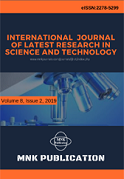DOI:10.29111/ijlrst ISRA Impact Factor:3.35, Peer-reviewed, Open-access Journal
Research Paper Open Access
International Journal of Latest Research in Science and Technology Vol.3 Issue 6, pp 187-191,Year 2014
Correspondence should be addressed to :
Received : 10 December 2014; Accepted : 25 December 2014 ; Published : 31 December 2014

| Download | 125 |
|---|---|
| View | 180 |
| Article No. | 10446 |
Albizia falcataria seems to be the best alternative as it is wood properties offer great usability and multipurpose tree. It is very fast growth and able to grow on variety of soils make it suitable as an alternative tree. Therefore, the basic density, fiber properties and chemical composition of Albizia falcataria were study according the effect of tree portion and distance from pith. The preliminary studies are important in order to make variety of products which nowadays it become insufficient resources according to the increment of human populations in the world.
Copyright © 2014 Muslyza Che Hussin et al. This is an open access article distributed under the Creative Commons Attribution 4.0 International (CC BY 4.0) license which permits unrestricted use, distribution, and reproduction in any medium, provided the original work is properly cited.
Muslyza Che Hussin, Jamaludin Kasim, Nur Farahin Yusoff, Nor Farhana Jasmi, Siti Nadzirah Misfar , " Effect Of Tree Portion And Distance From Pith On The Basic Density, Fiber Properties And Chemical Composition Of Albizia Falcatariawood ", International Journal of Latest Research in Science and Technology . Vol. 3, Issue 6, pp 187-191 , 2014

MNK Publication was founded in 2012 to upholder revolutionary ideas that would advance the research and practice of business and management. Today, we comply with to advance fresh thinking in latest scientific fields where we think we can make a real difference and growth now also including medical and social care, education,management and engineering.

We offers several opportunities for partnership and tie-up with individual, corporate and organizational level. We are working on the open access platform. Editors, authors, readers, librarians and conference organizer can work together. We are giving open opportunities to all. Our team is always willing to work and collaborate to promote open access publication.

Our Journals provide one of the strongest International open access platform for research communities. Our conference proceeding services provide conference organizers a privileged platform for publishing extended conference papers as journal publications. It is deliberated to disseminate scientific research and to establish long term International collaborations and partnerships with academic communities and conference organizers.